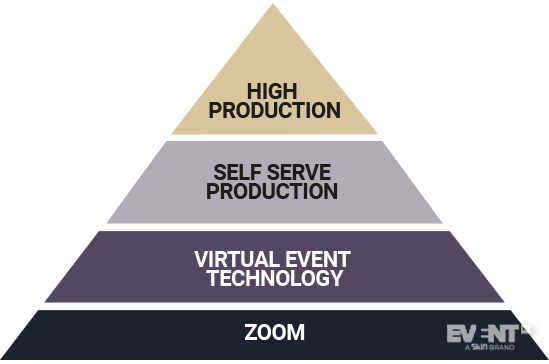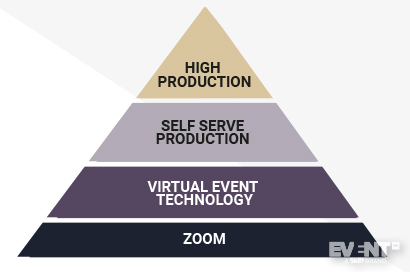At our latest event, I argued with a few of our speakers. While we discussed hybrid events, many on the panel started saying that they had ‘been doing hybrid events for years’.
Saying that anything we are experiencing today is remotely related to our industry before January 2020 is plain wrong.
Even those who have done virtual events before January 2020 have never experienced the demand and depth we witness these days. Whatever virtual event technology platforms were before the pandemic hit, that represents a tiny fraction of what they are today.
Virtual Events Are Not Going Anywhere
The meetings and events industry is based on the premise of attending an event to do some form of business. While we can envision and plan for a full industry comeback, it is fair to say that unless we have a safe way to travel, the meeting industry as we know it is not going to make a full comeback any time soon.
Yes, you may have local meetings, smaller hybrid experiences — but this is an industry running a 10 percent capacity.
The point at which the industry starts working is when big meetings are activated and people travel to attend conferences or trade shows.
Until safety is re-established and companies begin to send employees to events as well as resume sponsorships, virtual events are what we need to deal with.
This is not a virtual versus live conversation. It is mere facts. Many event technology companies I talked to confirm that the level of inbound requests they are receiving is at an all-time high, and there is no sign they are going down.
As much as we would all like to go back to live events, we are stuck with virtual for many months ahead and beyond that as part of hybrid events.
Event Professionals Know What they Want
Back in March, when this madness started, very few event professionals knew what they wanted. What many outsiders fail to understand is that professional planners deal with hundreds of events a year.
They very quickly learned what they wanted the hard way.
I spoke to Johnny Boufarhat, founder and CEO of Hopin, a virtual event platform that recently closed a $40M investment round — one of the highest ever for event technology.
He confirmed that requirements are evolving after the initial surge of planners selecting platforms based on a quick Google search.
“Event planners definitely know better what they want today and what to expect in virtual event platforms.”
Pierre Metrailler, CEO of SpotMe, agreed: “This is not an emergency anymore. This is strategic purchasing. Buyers are clearly more educated and running sophisticated selection processes.”
As a result, expectations are evolving. While having a Zoom meeting was OK in March and April, needs are getting more sophisticated.
The New Market of Virtual Event Technology
The evolving needs of event planners are reshaping the market offering. This is confirmed by multiple reviews, interviews, and analysis we have carried out over the past two months and scoping platforms for high profile events, including our own at EventMB and Skift.
Here is what the market looks like today:

There is a clear shift marked by many companies taking on Zoom, the real leader of the virtual event tech market.
While Zoom has been the only means of streaming events (either as a standalone platform or by means of integration), traditional event technology, AV, and trade show companies have not been watching them to set the paradigm.
They realized that the most comprehensive adoption that Zoom is having, from family reunions to elementary school classes, is one that creates a very formulaic, one-dimensional experience. This delivery goes against the very nature of events, being special and rich in the experience compartment.
As a result, the market developed as follows:
Zoom. Zoom remains the primary layer to run virtual events. Internal events and those events in need of a quick transition to virtual continue to prefer this platform for its reliability and easy-to-use interface.
Virtual Event Technology. In this category are all the platforms that were conceived as 100% virtual or that pivoted from a live component. After an initial integration strategy, many platforms are now developing a native streaming service that allows for some basic production level. This seems to be the key deciding factor for many event professionals. Having speakers to connect via Zoom and then feed into a virtual event platform can be somewhat of a nightmare. As a result, features such as three or four-speaker views, overlays, and lower thirds are popping up. This is a reality for many platforms we have reviewed, such as Pheedloop, Cadence, Socio, and Conference Compass.
This was also confirmed by Hopin’s Boufarhat, who says that creating overlays and light production enhancements is a priority for their platform.
Other virtual event tech companies such as SpotMe or Eventmobi offer production services, with members of their teams taking on the role of AV companies and producing the full event.
Those who solely rely on integrations for live streaming will soon be left behind by the market, or they will have to completely rely on RTMP streams, pushing the weight onto the planners’ budgets.
Self-Serve Production Platforms. These are tools that will soon be cannibalized by virtual event technology platforms. If, in fact, the above trend continues, their event business will soon be history. These are platforms such as Streamyard or OBS that help to create a better-than-zoom experience at a very low cost.
To date, the only instance where they are used is when the virtual event platform has a weak live streaming offering or relies on a Zoom integration. As more platforms develop their own tools, they will sunset very soon.
High Production Companies. While the event world was tumbling down, AV and production companies have not just been sitting there watching. More events are, in fact, happening with more sophisticated levels of production. As travel restrictions ease, TV studios are popping up, and companies such as GES and Freeman — previously dedicated to the trade show industry — are now investing in the production of high profile hybrid TV studio experiences.
Speaking to Kiel Jared, Global VP of Digital at GES, he reinforced the connection between higher production levels and experience “Every virtual and hybrid platform delivers videos and a digital experience, but the key differentiator for the exhibitor or the speaker is the quality of their experience.”
On the longer term and as budgets come back, we can expect more of these implementations with a direct RTMP to the event platform.
This is where the challenges for hybrid events will start.
Zoom is Ready to Move
Without really expecting it, Zoom has become the most valuable company in the history of the event industry. Assuming it will watch smaller players take chunks out of their gigantic industry market share is naive.
Multiple sources report that the company is moving into developing a better virtual event platform. Of all the players, they have the means to really revolutionize the virtual event experience.
The remaining questions, of course, concern Zoom’s capability to develop a targeted product with the incredible legacy and user base they have. This will be a flexibility game, though they have shown a constant stream of releases (even if trivial) over the past few months.
IN CONCLUSION
A Zoom call is not a virtual event. Attendees know it, planners know it. The virtual event exercise of the past six months has been pushing the virtual event market towards a new shake-up.
The new offer sees production value higher up on the requirements list, and many event technology companies are transitioning to offer some level of meeting production capabilities.
Meanwhile, AV and production companies are putting themselves ahead of the curve in hybrid event delivery. As we go back to live meetings, virtual-only platforms will struggle and virtual event technology will gain speed.
The silent giant, Zoom, is not watching its market share go away, effectively making this a developing story. Interesting times ahead.





